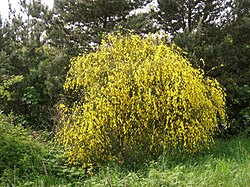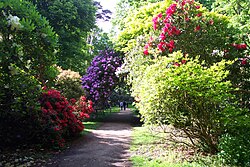Shrub

 Clash Royale CLAN TAG#URR8PPP
Clash Royale CLAN TAG#URR8PPP 
A broom shrub in flower

A rhododendron shrubbery in Sheringham Park
A shrub or bush is a small- to medium-sized woody plant. Unlike herbs, shrubs have persistent woody stems above the ground. They are distinguished from trees by their multiple stems and shorter height, and are usually under 6 m (20 ft) tall.[1] Plants of many species may grow either into shrubs or trees, depending on their growing conditions. Small, low shrubs, generally less than 2 m (6.6 ft) tall, such as lavender, periwinkle and most small garden varieties of roses, are often termed "subshrubs".[2]
Contents
1 Use in parks
2 Botanical structure
3 List of shrubs (bushes)
4 References
Use in parks

Euonymus bushes in a garden
An area of cultivated shrubs in a park or a garden is known as a shrubbery.[3] When clipped as topiary, suitable species or varieties of shrubs develop dense foliage and many small leafy branches growing close together.[4] Many shrubs respond well to renewal pruning, in which hard cutting back to a "stool" results in long new stems known as "canes".[clarification needed] Other shrubs respond better to selective pruning to reveal their structure and character.
Shrubs in common garden practice are generally considered broad-leaved plants, though some smaller conifers such as mountain pine and common juniper are also shrubby in structure. Species that grow into a shrubby habit may be either deciduous or evergreen.[5]
Botanical structure

Shrub vegetation (with some cactus) in Webb County, Texas.

Blackthorn shrub (Prunus spinosa) in the Vogelsberg

Hydrangea macrophylla
In botany and ecology, a shrub is more specifically used to describe the particular physical structural or plant life-form of woody plants which are less than 8 metres (26 ft) high and usually have many stems arising at or near the base.
For example, a descriptive system widely adopted in Australia is based on structural characteristics based on life-form, plus the height and amount of foliage cover of the tallest layer or dominant species.[6]
For shrubs 2–8 metres (6.6–26.2 ft) high the following structural forms are categorized:
- dense foliage cover (70–100%) — closed-shrub
- mid-dense foliage cover (30–70%) — open-shrub
- sparse foliage cover (10–30%) — tall shrubland
- very sparse foliage cover (<10%) — tall open shrubland
For shrubs less than 2 metres (6.6 ft) high the following structural forms are categorized:
- dense foliage cover (70–100%) — closed-heath or closed low shrubland—(North America)
- mid-dense foliage cover (30–70%) — open-heath or mid-dense low shrubland—(North America)
- sparse foliage cover (10–30%) — low shrubland
- very sparse foliage cover (<10%) — low open shrubland
List of shrubs (bushes)
Those marked with * can also develop into tree form.
|
|
|
References
^ Anna Lawrence; William Hawthorne (2006). Plant Identification: Creating User-friendly Field Guides for Biodiversity Management. Routledge. pp. 138–. ISBN 978-1-84407-079-4.
^ Peggy Fischer (1990). Essential shrubs: the 100 best for design and cultivation. Friedman/Fairfax Publishers. pp. 9–. ISBN 978-1-56799-319-6.... Examples of subshrubs include candytuft, lavender, and rosemary. These broad definitions are ...
^ Patrick Whitefield (2002). How to Make a Forest Garden. Permanent Publications. pp. 113–. ISBN 978-1-85623-008-7.
^ Varkulevicius, Jane (17 May 2010). "Pruning for Flowers and Fruit". Csiro Publishing. Retrieved 19 December 2017 – via Google Books.
^ Elliott, Franklin Reuben (1 November 2008). "Popular Deciduous and Evergreen Trees and Shrubs". Applewood Books. Retrieved 19 December 2017 – via Google Books.
^ Costermans, L. F. (1993) Native trees and shrubs of South-Eastern Australia. rev. ed. ISBN 0-947116-76-1


Comments
Post a Comment